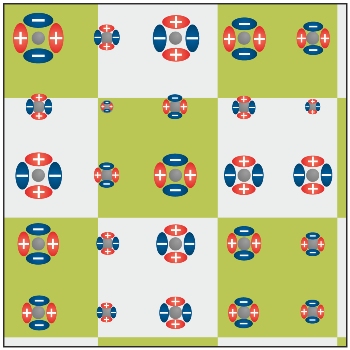Jun 10 2013
A German-French research team has constructed a new model that explains how the so-called pseudogap state forms in high-temperature superconductors. The calculations predict two coexisting electron orders.
 At each copper atom (grey balls) there is a quadrupole moment. All together, these form a kind of chessboard pattern, whereby the individual squares of the chessboard differ in the orientation of the positively and negatively charged areas (green: positive areas left and right; grey: positive areas top and bottom). At the boundaries between green and grey surfaces, the signs change. Copper atoms close to the boundary have a smaller quadrupole moment than copper atoms in the middle of the areas. © Konstantin Efetov und Hendrik Meier (Institut für Theoretische Physik III)
At each copper atom (grey balls) there is a quadrupole moment. All together, these form a kind of chessboard pattern, whereby the individual squares of the chessboard differ in the orientation of the positively and negatively charged areas (green: positive areas left and right; grey: positive areas top and bottom). At the boundaries between green and grey surfaces, the signs change. Copper atoms close to the boundary have a smaller quadrupole moment than copper atoms in the middle of the areas. © Konstantin Efetov und Hendrik Meier (Institut für Theoretische Physik III)
Below a certain temperature, superconductors lose their electrical resistance and can conduct electricity without loss. “It is not to be excluded that the new pseudogap theory also provides the long-awaited explanation for why, in contrast to conventional metallic superconductors, certain ceramic copper oxide bonds lose their electrical resistance at such unusually high temperatures”, say Prof. Dr. Konstantin Efetov and Dr. Hendrik Meier of the Chair of Theoretical Solid State Physics at the Ruhr-Universität Bochum. They obtained the findings in close cooperation with Dr. Catherine Pépin from the Institute for Theoretical Physics in Saclay near Paris. The team reports in the journal “Nature Physics”.
Transition temperature much higher in ceramic than in metallic superconductors
Superconductivity only occurs at very low temperatures below the so-called transition temperature. In metallic superconductors, this is close to the absolute zero point of 0 Kelvin, which corresponds to about -273 degrees Celsius. However, crystalline ceramic materials can be superconductive at temperatures up to 138 Kelvin. For 25 years, researchers puzzled over the physical bases of this high-temperature superconductivity.
Pseudogap: energy gap above the transition temperature
In the superconducting state, electrons travel in so-called Cooper pairs through the crystal lattice of a material. In order to break up a Cooper pair so that two free electrons are created, a certain amount of energy is needed. This difference in the energy of the Cooper electrons and the so-called free electrons is called an energy gap. In cuprate superconductors, compounds based on copper oxide bonds, a similar energy gap also occurs under certain circumstances above the transition temperature – the pseudogap. Characteristically the pseudogap is only perceived by electrons with certain velocity directions. The model constructed by the German-French team now allows new insights into the physical inside of the pseudogap state.
Two competing electron orders in the pseudogap state
According to the model, the pseudogap state simultaneously contains two electron orders: d-wave superconductivity, in which the electrons of a Cooper pair revolve around each other in a cloverleaf shape, and a quadrupole density wave. The latter is a special electrostatic structure in which every copper atom in the two-dimensional crystal lattice has a quadrupole moment, i.e. two opposite regions of negative charge, and two opposite regions of positive charge. d-wave superconductivity and quadrupole density wave compete with each other in the pseudogap state. Due to thermal fluctuations, neither of the two systems can assert itself. However, if the system is cooled down, the thermal fluctuations become weaker and one of the two systems prevails: superconductivity. The critical temperature at which this occurs can, in the model, be considerably higher than the transition temperature of conventional metallic superconductors. The model could thus explain why the transition temperature in the ceramic superconductors is so much higher.
Cuprates
High-temperature copper oxide superconductors are also called cuprates. In addition to copper and oxygen, they can, for example, contain the elements yttrium and barium (YBa2Cu3O7). To make the material superconducting, researchers introduce “positive holes”, i.e. electron holes into the crystal lattice. Through these, the electrons can “flow” in Cooper pairs. This is known as hole doping. The pseudogap state only sets in when the hole doping of the cuprate is neither too low nor too high.
Bibliographic record
K.B. Efetov, H. Meier, C. Pépin (2013): Pseudogap state near a quantum critical point, Nature Physics, DOI: 10.1038/NPHYS2641